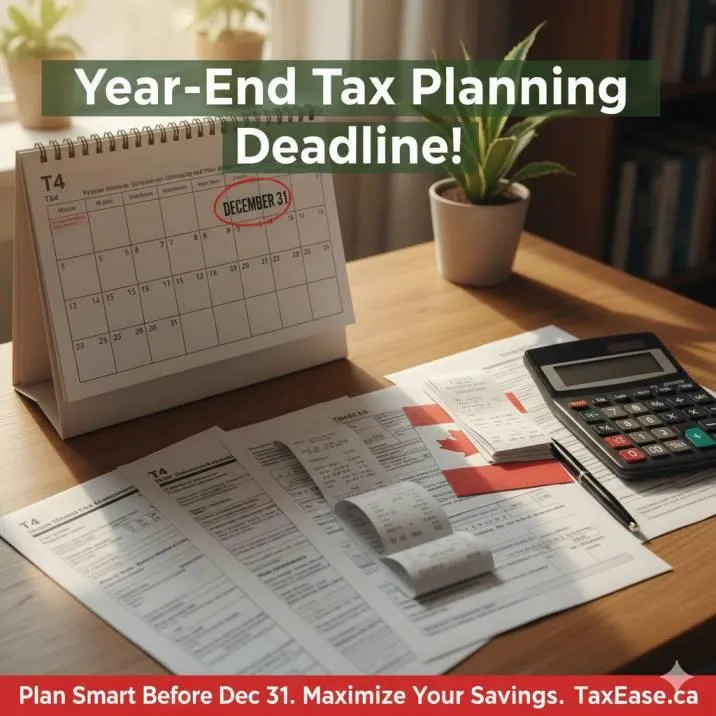Learning Center


Year-End Tax Planning: Steps to Take Before December 31st
Why Year-End Tax Planning Matters
The end of the year isn’t just about holiday shopping and celebrations—it’s also your last chance to make smart financial moves that can significantly lower your tax bill. Whether you’re an individual, a family, or a small business owner, year-end tax planning in Canada can mean the difference between overpaying taxes and keeping more of your hard-earned money.
From RRSP contributions to tax-loss selling strategies, December 31 acts as a hard deadline for many opportunities. With the right planning, you can maximize tax deductions, defer income, and stay fully compliant with CRA rules. At Taxease, we guide Canadians in turning tax planning into long-term financial advantage.

The December 31 Tax Checklist Every Canadian Should Know
Many taxpayers make the mistake of waiting until tax filing season to think about their taxes. But by then, it’s too late to make impactful changes. Here’s your December 31 tax checklist:
✅ Contribute to your TFSA (tax-free growth is best maximized earlier).
✅ Consider charitable donations for a tax credit.
✅ Prepay deductible expenses (e.g., medical costs, childcare).
✅ Review investment portfolio for tax-loss selling opportunities.
✅ Accelerate business expenses if you’re self-employed.
✅ Check your Home Buyers’ Plan (HBP) repayment due date.
Each of these steps can directly impact your taxable income for 2024 and beyond.

RRSP vs. TFSA — Which Should You Prioritize Before Year-End?
RRSP Contributions and Deadlines
While RRSP contributions for the 2024 tax year can be made until March 1, 2025, December is still a good time to evaluate your contribution strategy. For high-income earners, maximizing RRSP contributions helps reduce taxable income and defer taxes until retirement.
📌 Quick Tip: The last day to maximize RRSP contributions is not December 31, but planning now helps avoid scrambling before March.
TFSA Contributions
Unlike RRSPs, TFSA contributions don’t reduce taxable income, but they allow your investments to grow tax free. The 2024 TFSA limit is $7,000, with a total cumulative contribution room of $95,000 (for those eligible since 2009).
🔑 Strategy: If you’re carrying investments with growth potential, consider moving them into a TFSA before December 31 to maximize tax-free gains.

Tax-Loss Selling Strategy Canada
If your investment portfolio has underperforming assets, tax-loss selling allows you to offset capital gains by selling those investments at a loss.
Key Rules to Remember
The trade must settle before December 31 to count for 2024.
The settlement period (T+2) means trades should be executed by December 27 at the latest.
Losses can offset capital gains for the current year or be carried forward/backward.
For example, if you sold shares at a $10,000 gain earlier in the year but now sell another at a $7,000 loss, your taxable capital gain is reduced to $3,000.
👉 For detailed CRA rules on capital gains, visit the Government of Canada’s capital gains guide.


Charitable Donations and Tax Credits
Making a charitable donation before December 31 can provide a generous tax credit.
Donations up to $200 get a 15% federal credit.
Donations over $200 receive a 29% federal credit (33% for high-income earners).
Provinces also provide additional credits.
For example, a $1,000 donation in Ontario could generate a combined credit of nearly $400.
Make sure you donate to registered charities to qualify. You can verify organizations through the CRA Charities Listings.
Year-End Tax Planning for Small Business Owners
Small businesses and self-employed Canadians have unique opportunities:
Accelerate expenses: Buy equipment, pay rent, or settle supplier invoices before year-end.
Defer income: Push December invoices into January to delay income recognition.
Consider incorporation if your income has grown significantly.
Pay yourself dividends strategically to split income.
At Taxease, we work with entrepreneurs to design small business tax planning strategies that minimize liability while optimizing cash flow.

Medical Expenses and Other Year-End Deductions
Medical expenses are only deductible if they exceed a certain threshold (3% of your net income or the CRA’s minimum). Paying outstanding bills before December 31 may increase your medical expense tax credit eligibility.
Other deductions to consider before year-end:
Childcare expenses
Union or professional dues
Investment carrying charges
The Home Buyers’ Plan (HBP) Repayment Deadline
If you withdrew from your RRSP under the Home Buyers’ Plan, you must repay the annual required amount by December 31. Missing this repayment means the amount will be added to your taxable income.

Year-End Deadlines and CRA Compliance
Here are some key CRA deadlines to remember:
December 31, 2024:
Charitable donations for 2024 tax credit.
Medical and childcare expenses for 2024.
TFSA contributions for the year.
HBP and LLP repayments.
December 27, 2024: Last trading day for tax-loss selling (T+2 settlement).
March 1, 2025: Last day to contribute to your RRSP for the 2024 tax year.
For official details, check CRA’s important dates for individuals.

Make Year-End Tax Planning Work for You
Year-end tax planning isn’t just about avoiding mistakes—it’s about seizing opportunities. From maximizing RRSP and TFSA contributions to taking advantage of tax-loss selling and charitable donation credits, every decision before December 31 can impact your financial picture for years to come.
At Taxease, we help Canadians navigate complex rules, reduce tax burdens, and plan for the future with confidence. Don’t wait until tax season—act now to secure your savings.

👉 Ready to maximize your deductions and meet all CRA deadlines? Contact Taxease today for personalized year-end tax planning strategies tailored to your needs.
TaxEase.ca is a Canadian tax preparation and accounting firm serving individual and corporate clients Canada-wide.
Useful Links
©2025 . All Rights Reserved.
